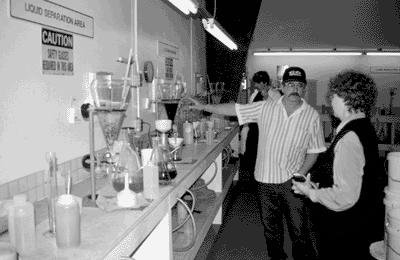Industry interaction

The Slave Craton in fusion: Sue O'Reilly visiting the accredited caustic fusion laboratory for diamond recovery at Kennecott Canada Inc. laboratories in Thunder Bay, Canada. Sue O'Reilly, Bill Griffin and Rondi Davies spent time with collaborators at Kennecott as part of the SPIRT project on the Slave Craton.
Industry interaction, technology transfer and commercialisation program
GEMOC relies on a vigorous interaction with the mineral exploration industry at both the research and the teaching/training levels. The research results of the Centre's work are transferred to the industry and to the scientific community by:
- interaction through collaborative industry-supported Honours, MSc and PhD projects
- short courses relevant to the industry and government sector users, designed to communicate and transfer new technologies, new techniques and new knowledge in the discipline areas covered by the Key Centre
- one-on-one research collaborations and shorter-term consultancies on industry problems involving national and international partners
- provision of high quality geochemical analysis and interpretations to industry and government organisations, extending our industry interface
- use of Macquarie Research Limited and INAX (ANU) consultancies, which employ and disseminate the technological developments carried out by the Centre
- GLITTER, an on-line data-reduction program for Laser Ablation ICPMS analysis developed by GEMOC and (CSIRO GEMOC participants), is available commercially through Merchantek EO.
- collaborative relationships with technology manufacturers (more detail in the section on Technology Development):
- GEMOC (Macquarie) is the Hewlett Packard ICPMS Australian demonstration site
- GEMOC (Macquarie) is the international Alpha test site for Merchantek Lasers
Support sources
GEMOC industry support includes:
- direct funding of research programs
- "in kind" funding including field support (Australia and overseas), access to proprietary databases, sample collections, digital datasets
- collaborative research programs (eg SPIRT, APA Industry and PhD program support)
- assistance in the implementation of GIS technology in postgraduate programs
- participation of industry colleagues as guest lecturers in senior courses (eg Bachelor of Technology)
- extended visits to Macquarie by industry personnel for interaction and research
- The mineral exploration industry provided funding for three postgraduate student projects in 1999. In each case, the companies have provided invaluable in-kind support, and have been closely involved in shaping the research project.
- A new collaborative research project with Kennecott Canada Inc., funded by a SPIRT grant, was started within the Lithosphere Mapping strand. GEMOC staff visited Kennecott operations in Vancouver and Thunder Bay during 1999, and Kennecott and Diavik staff came to Macquarie. The earlier work on the collaborative projects leading to the SPIRT grant resulted in several high-profile publications on the nature and evolution of the lithosphere beneath the Slave Craton in arctic Canada (eg Publication numbers 137, 139, 144).
- 17 Industry Reports completed for collaborative and consulting projects
- A new collaborative project using gravity data of the Siberian lithosphere to interpret effective elastic thickness and integrate this with tectonic analysis and geochemical data, was undertaken with a collaborative WMC/Macquarie University Grant and geophysical data provided by VSEGEI, St Petersburg. This represents an expansion of the very successful 1998 project, to cover the whole of the Siberian Platform. Planning and workshop sessions at Macquarie with participants from WMC, VSEGEI and GEMOC were key activities (eg Publication number 154).
- De Beers (Johannesburg), who provided capital contributory funding for the new MC-ICP-MS, have continued a schedule of regular visits to Macquarie to participate in aspects of the development of LAM-ICPMS and MC-ICPMS techniques and applications.
- BHP sponsored a strand of technology development (and a related research project) on the LAM-ICPMS, up to the dramatic reduction of staff in BHP in mid-1999. The new exploration consulting group GeoDiscovery, has continued this support, and is actively working with GEMOC to develop techniques for terrane analysis (see Research Highlights). A GeoDiscovery/Macquarie collaborative project will support this project in 2000. Dr Steve Walters visits Macquarie frequently to participate in this collaboration,
- Many companies have provided high levels of in-kind support in the form of samples: these include access to diamonds and xenoliths through Rio Tinto and Kennecott Canada, and suites of xenoliths from Ashton Mining of Canada.
- Numerous industry visitors spent varying periods at GEMOC in 1999 to discuss our research and technology development (see visitor list, Appendix 3)
- DIATREEM continued to provide LAM-ICPMS analyses of garnets and chromites to the diamond-exploration industry on a routine basis, in cooperation with CSIRO, North Ryde.
- At ANU (Blevin, Chappell) "Igneous Metallogenic Systems of Eastern Australia" was funded by AMIRA (Project P515) with extra funding from an ANU Endowment for Excellence.
- GEMOC publications, preprints and non-proprietary reports are available on request for industry libraries

 GEMOC ARC National Key Centre
GEMOC ARC National Key Centre